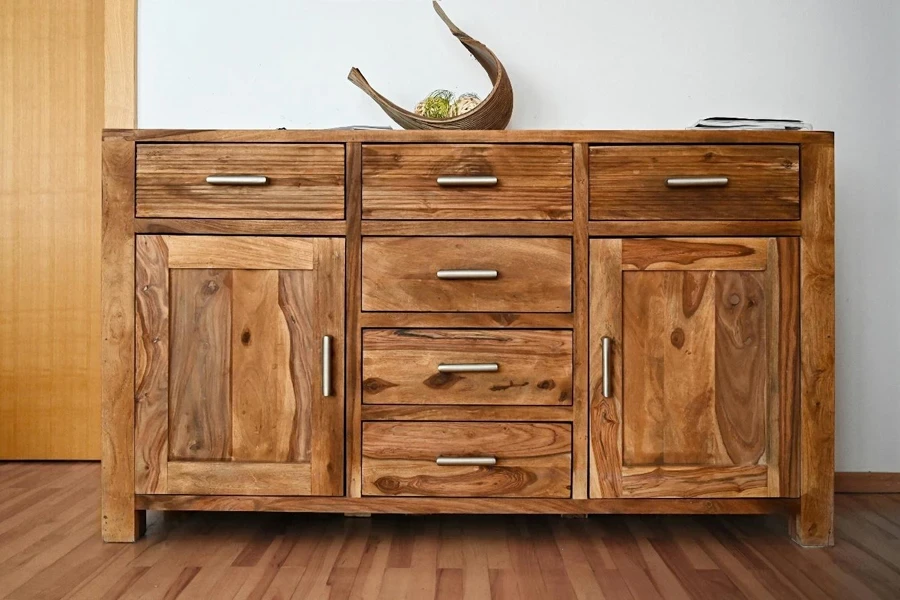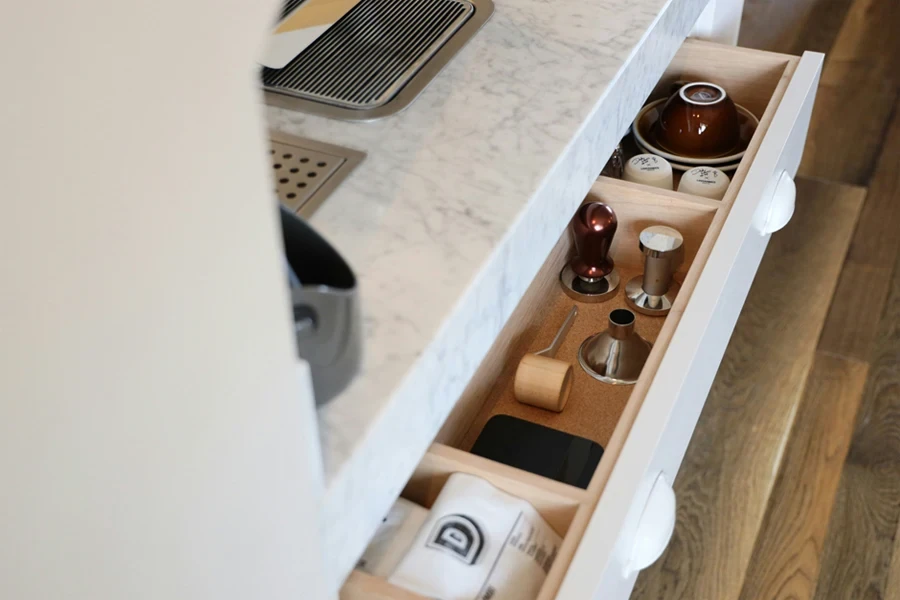Table of Contents
● Introduction
● Market overview
● Different types of storage drawers
● Things to consider when selecting products
● Conclusion
Introduction

Effective and stylish storage solutions are crucial for households and businesses alike. Drawer storage offers a choice that boosts tidiness and ease of access to belongings. This manual explores the market trends in storage drawers, the range of drawer types available, and important considerations when choosing the right products. This article provides information on market expansion and specific product attributes to empower professionals to make informed buying choices. Read on to discover how varied materials, styles, and features can cater to storage requirements in diverse environments.
Market overview

Market scale and growth
In 2023, the global market for modular storage systems was worth $3.33 billion and is estimated to grow at a compound annual growth rate of 4.1% to reach $4.41 billion by 2030. North America leads the market with a share of over 30%, mainly due to rising demand from retail and e-commerce industries. Europe’s case has a 25 percent market share driven by the increasing use of storage options; meanwhile, the Asia Pacific region is witnessing the most significant growth with an anticipated annual growth rate of more than 5% attributed to the speedy urban development and industrial progress in nations, like India and Indonesia.
Key trends
The market is growing due to the booming e-commerce sector, which requires storage solutions for managing larger inventories smoothly and expandably. Moreover, the uptick in building ventures drives the need for flexible storage units as homeowners seek personalized and compact choices. Trends shaping the market involve the rising appeal of storage solutions, incorporating automated storage and retrieval systems (ASRS), and a shift towards using environmentally friendly materials to support sustainability objectives.
Different types of storage drawers

Wooden drawers
Wood drawers offer a visually pleasing option in living spaces and bedrooms. Some kinds of wood like oak, pine, and MDF are commonly used to make them, each with advantages. With a hardness rating of 1,300 from the Janka scale oak, it is known for its durability and timeless appeal. Pine sports a lower Janka rating of around 380, which lends it a lighter, more countryside look and makes it susceptible to marks and scratches. Engineered wood product MDF offers a surface that is simple to paint or cover with veneer at an affordable price point option. In drawer designs, you will get various choices, from classic dovetail joints to contemporary push-to-openpush-to-open features offering flexibility in home decoration.
Plastic drawers
Plastic drawers are a budget-lightweight option for organizing stuff in children’s bedrooms and garages. They are commonly crafted from polypropylene or ABS plastic materials that can withstand moisture and chemicals well, making them great for storing items in tough conditions. The material’s strength is about 4,800 psi for polypropylene, providing decent durability. Features may include frosted surfaces, built-in handles, and optional stacking ability. Plastic drawers are preferred for their affordability and easy upkeep compared to wood or metal options.
Metal drawers
Metal drawers are popular for their durability and industrial aesthetics, making them a great fit for office spaces and workshops. Crafted from materials like galvanized steel or aluminum to withstand wear and tear effortlessly while offering impressive tensile strength (up to 50,000 psi for galvanized steel) and they are resistant to rusting These sturdy drawers often come with powder-coated finishes that boost their longevity and give them a stylish edge in any setting they’re placed in. They are capable of holding weight, typically around 100 lbs per drawer. Metal drawers are perfect for storing those heavy-duty tools and equipment securely. Common styles often feature ball-bearing slide mechanisms for functionality and designs with locks for enhanced security.
Wicker drawers
Drawers made from wicker offer a down-to-earth look that fits well with beach-themed or country-inspired interiors. Crafting them out of materials like rattan or seagrass gives these drawers a balance of lightness and strength. For example, wicker baskets woven from rattan boast a tensile strength of 20 MPa, resulting in flexibility and resilience. Their natural fibers promote air circulation, making them an excellent choice for storing items that need to breathe, such as linens or garments. To keep them in shape, simply dust them regularly and give them an occasional wipe-down with gentle soap to prevent mold formation and mildew. Adding wicker drawers brings a natural feel and elevates the visual appeal with their distinctive texture and allure.
Fabric drawers
Soft and collapsible fabric drawers are a storage option for closets and laundry rooms due to their lightweight nature and ease of handling. Typically crafted from materials such as canvas or polyester fabric with a strength of around 4,400 psi, these drawers can be easily folded flat for compact storage when not in use. They offer advantages in terms of flexibility and affordability, often coming equipped with reinforced handles for effortless carrying, and are available in a range of colors and patterns to complement any design scheme. Storage bins made of fabric are great for keeping your clothing items and accessories tidy and well-organized in your home. They come in styles with built-in wireframes to help them keep their shape intact.
Design features
Storage drawers nowadays often come with design elements to improve their usability and make things more convenient for users. Stackable layouts let people make the most out of space while ensuring stability through interlocking mechanisms. Modular setups allow users to adjust storage units based on their requirements. Divider compartments inside help maintain order in the drawers. Adding wheels with locks makes moving them around a breeze. Modern functionalities such as gentle closing drawer slides prevent drawer closures, and built-in charging ports and lighting improve usability in present-day environments.
Things to consider when selecting products

Size and dimensions
Choosing the size and dimensions for storage drawers is important to ensure they fit perfectly in the space you have in mind. To start off with this process, measuring the space available is key. Considering the height, width, and depth limitations, it’s also important to ensure space around the drawers so they can open easily and for proper ventilation. For instance, if you plan to use drawers for under-bed storage, ensure there’s at least 6 inches of clearance height. When selecting the size of drawers for storage purposes, it is important to consider the types of items that will be stored within them. Deeper drawers, typically 12 to 18 inches deep, are best suited for bulkier objects.
Conversely, shallower drawers ranging from 6 to 9 inches are more suitable for storing smaller accessories and items. Opting for drawer designs stacked atop one another can help maximize space utilization, particularly in smaller rooms with limited space. The stackable drawers often come in varying heights, ranging from 36 to 72 inches tall.
Material considerations
The type of material used in storage drawers greatly affects how long they last, how they look well, and their suitability for various settings.
Wood
Kinds of wood such as oakwood durability at approximately 0.75 g/cm³ gives a classic appearance but comes with a higher price tag compared to the lighter and more budget-friendly pine wood at 0.43 g/cm³, which adds a touch, albeit being susceptible, to scratches. Medium-density fiberboard (MDF), with a density of 0.69 g/cm³, is an affordable choice that offers a sleek surface perfect for painting or applying veneer.
Metal
Metal drawers are well known for their durability and rugged appearance. They are commonly crafted from galvanized steel or aluminum materials. Galvanized steel is recognized for its robustness and ability to withstand loads due to its tensile strength ranging from 400 to 550 MPa. It is ideal for use in both workshop settings and office environments. IAluminum drawers are lighter in weight. They offer a tensile strength between 70 and 700 MP while boasting rust resistance as an added advantage.
Plastic
Plastic storage containers are commonly crafted from polypropylene or ABS (Acrylonitrile Butadiene Styrene). They are known for being lightweight, budget-friendly, and resistant to moisture and chemicals. Despite not possessing the durability of wood or metal alternatives, these qualities make them a great choice for spaces like garages and children’s rooms.
Style and aesthetics
The design and look of storage drawers should match the décor of the room they’re in perfectly! Classic styles usually have detailed patterns and wood finishes such as mahogany or cherry that go well with traditional themed spaces. Modern styles lean towards lines and simple designs with materials like metal or glossy surfaces such as lacquered MDF. Various color and finish options are available, from natural wood tones with unique grain patterns (like oak with its distinct grain texture) to vibrant shades and either matte or shiny finishes. Selecting the style elevates the aesthetic charm and harmony of the room’s complete design.
Storage needs
Determining how much storage space is necessary is crucial when choosing the arrangement of drawers in a certain area or room layout. The quantity of drawers needed varies based on the amount and kinds of objects that require storage. For example, kitchens and workspaces could benefit from small drawers (usually 4 to 6 inches deep) that are ideal for storing tools and office supplies. On the other hand, bedrooms might require deeper drawers (ranging from 12 to 18 inches deep) suitable for organizing clothing items. Finding a mix of deep and shallow drawers can enhance efficiency and ease of access in organizing your belongings. Some designs include integrated separators crafted from materials such as acrylic or bamboo, aiding in organizing items within drawers and enhancing their functionality by making it easier to locate objects.
Functionality
Enhanced features play a role in improving the convenience and security of storage compartments like drawers. Many people prefer close systems that employ hydraulic dampers because they prevent drawers from slamming shut and help reduce noise levels while extending the drawers’ life. For safety purposes in households with children or to prevent accidents like tipping over drawers, weighty anti-tip kits equipped with steel brackets and straps are highly important as they secure the drawers to the wall. Integrated locks, either key-operated or electronically controlled mechanisms, are commonly used to safeguard sensitive belongings in these storage spaces. Extra functionalities like caster wheels. Often crafted from polyurethane for movement and able to bear up to 100 pounds per wheel. Provide mobility and simplify moving drawers when necessary. The modular design lets individuals personalize and extend their storage options based on evolving needs, which provides a method of organization. These practical upgrades are crucial for adjusting storage solutions to demands and settings.
Conclusion

Selecting the appropriate storage drawers can greatly improve organization and efficiency. You should consider trends in the market and the diverse types of storage options available to make informed choices that suit individual requirements effectively. It helps to maximize space use and enhance productivity in both home and work settings.




